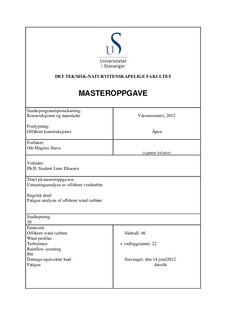| dc.description.abstract | In this master thesis analyses will be conducted on a 5MW offshore wind turbine, with a
jacket foundation. The goal is to investigate how seven different wind profiles affect fatigue
in the blade root, the tower top and the tower bottom. The effect of the turbulence level is also
investigated. The analyses examine how the fatigue loads differs from one wind profile to the
next, which means it is actually the relative fatigue that is being calculated.
There are a total of seven wind profiles investigated, based on the logarithmic wind profile
formula. Due to limitations in the software used, power law wind profiles are used in the
analysis. The seven wind profiles have different shear, but the differences are small.
Calculations have been made to determine which wind profile that is expected to cause the
greatest damage. For each wind profiles the turbulence intensity (TI) is changed from 25 % to
11 % to 0 %, to investigate how this will impact. By including turbulence one gets wind
fields. The wind fields are simulated by the software application Turbsim.
The wind fields cause different load impact. The loads are calculated by the multi-body
software called Fedem Windpower. The loads are then post-processed by Mlife, which is a
MatLab application, in order to obtain damage equivalent load (DEL), i.e. relative fatigue.
The DEL’s are tabulated in the result chapter for the 18 load conditions analyzed, where the
turbulence is reduced from 25 % to 11 % to 0 %. All the DEL’s are normalized with respect
to the neutral wind profile. Additionally, the result chapter shows graphically the normalized
values for selected loads.
DEL caused by the bending moment out of plane (RMy) is considered most significant to
investigate which of the wind profiles that are causing the highest DEL. The result chapter
shows DEL results caused by RMy that are not as expected when turbulence is included. In
the discussion chapter this case is widely discussed. It appears that the reason has to do with
the fact that the mean turbulence variation on both sides of one wind profile is larger than the
difference between the wind profiles. Since the turbulence simulation is random and the
difference between the wind profiles is small, the mean value variation due to random
turbulence can be larger than the variation between any of the seven wind profiles. For this
reason it is difficult to draw any conclusion when turbulence is included. If however, the
turbulence is ignored, the expected results are achieved.
Conclusion:
* No turbulence; the expected results are achieved
* Turbulence included; no clear results | no_NO |
